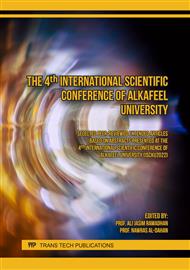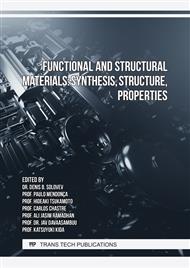[1]
Alkaabi, Zaid K. Synthesis and Characterization of ZnO Nanoparticles via Aloe Vera Extract. In: Materials Science Forum. Trans Tech Publications Ltd, 2021. pp.211-214.
DOI: 10.4028/www.scientific.net/msf.1039.211
Google Scholar
[2]
Tomaa, G. A., Alkaabi, Z. K., & Mohammed, M. S. (2022). Synthesis and Characterization of Copper Oxide Nanoparticles for Perovskite Solar Cell Applications. NeuroQuantology, 20(4), 382-388.
DOI: 10.14704/nq.2022.20.4.nq22134
Google Scholar
[3]
Alkaabi, Z. K., & Al-Shakarchi, E. K. (2021). Studying the Physical Properties of Bi-2223 Nanostructure Prepared Thermal Treatment Method. In Materials Science Forum (Vol. 1039, pp.269-273). Trans Tech Publications Ltd.
DOI: 10.4028/www.scientific.net/msf.1039.269
Google Scholar
[4]
Bellissima, F., Bonini, M., Giorgi, R., Baglioni, P., Barresi, G., Mastromei, G., & Perito, B. (2014). Antibacterial activity of silver nanoparticles grafted on stone surface. Environmental Science and Pollution Research, 21(23), 13278-13286.
DOI: 10.1007/s11356-013-2215-7
Google Scholar
[5]
Morones, J. R., Elechiguerra, J. L., Camacho, A., Holt, K., Kouri, J. B., Ramírez, J. T., & Yacaman, M. J. (2005). The bactericidal effect of silver nanoparticles. Nanotechnology, 16(10), 2346.
DOI: 10.1088/0957-4484/16/10/059
Google Scholar
[6]
Kim J S, Kuk E, Yu K N, Kim J-H, Park S J, Lee H J, Kim S H, Park Y K, Park Y H, Hwang C-Y, et al. Nanomedicine: NBM. 2007;3:95–101.
DOI: 10.1016/j.nano.2006.12.001
Google Scholar
[7]
Xiu, Z. M., Zhang, Q. B., Puppala, H. L., Colvin, V. L., & Alvarez, P. J. (2012). Negligible particle-specific antibacterial activity of silver nanoparticles. Nano letters, 12(8), 4271-4275.
DOI: 10.1021/nl301934w
Google Scholar
[8]
Ivask, A., Elbadawy, A., Kaweeteerawat, C., Boren, D., Fischer, H., Ji, Z., ... & Godwin, H. A. (2014). Toxicity mechanisms in Escherichia coli vary for silver nanoparticles and differ from ionic silver. ACS Nano 8: 374–386. Link: https://bit. ly/3COLsen. [9] Feng Q L, Wu J, Chen G Q, Cui F Z, Kim T N, Kim J O. J Biomed Mater Res. 2000;52:662–668. doi: 10.1002/1097-4636(20001215)52:4<662::AID-JBM10>3.0.CO;2-3.
DOI: 10.1021/nn4044047
Google Scholar
[9]
Grade, S., Eberhard, J., Wagener, P., Winkel, A., Sajti, C. L., Barcikowski, S., & Stiesch, M. (2012). Therapeutic Window of Ligand‐Free Silver Nanoparticles in Agar‐Embedded and Colloidal State: In Vitro Bactericidal Effects and Cytotoxicity. Advanced Engineering Materials, 14(5), B231-B239.
DOI: 10.1002/adem.201180016
Google Scholar
[10]
Ivask, A., ElBadawy, A., Kaweeteerawat, C., Boren, D., Fischer, H., Ji, Z., ... & Godwin, H. A. (2014). Toxicity mechanisms in Escherichia coli vary for silver nanoparticles and differ from ionic silver. ACS nano, 8(1), 374-386.
DOI: 10.1021/nn4044047
Google Scholar
[11]
Marambio-Jones, C., & Hoek, E. (2010). A review of the antibacterial effects of silver nanomaterials and potential implications for human health and the environment. Journal of nanoparticle research, 12(5), 1531-1551.
DOI: 10.1007/s11051-010-9900-y
Google Scholar
[12]
Silver, S. (2003). Bacterial silver resistance: molecular biology and uses and misuses of silver compounds. FEMS microbiology reviews, 27(2-3), 341-353.
DOI: 10.1016/s0168-6445(03)00047-0
Google Scholar
[13]
Pandey, J. K., Swarnkar, R. K., Soumya, K. K., Dwivedi, P., Singh, M. K., Sundaram, S., & Gopal, R. (2014). Silver nanoparticles synthesized by pulsed laser ablation: as a potent antibacterial agent for human enteropathogenic gram-positive and gram-negative bacterial strains. Applied biochemistry and biotechnology, 174(3), 1021-1031..
DOI: 10.1007/s12010-014-0934-y
Google Scholar
[14]
Sintubin, L., Verstraete, W., & Boon, N. (2012). Biologically produced nanosilver: current state and future perspectives. Biotechnology and Bioengineering, 109(10), 2422-2436..
DOI: 10.1002/bit.24570
Google Scholar
[15]
Muniz‐Miranda, M. (2013). SERS investigation on the adsorption and photoreaction of 4‐nitroanisole in Ag hydrosols. Journal of Raman Spectroscopy, 44(10), 1416-1421.
DOI: 10.1002/jrs.4236
Google Scholar



